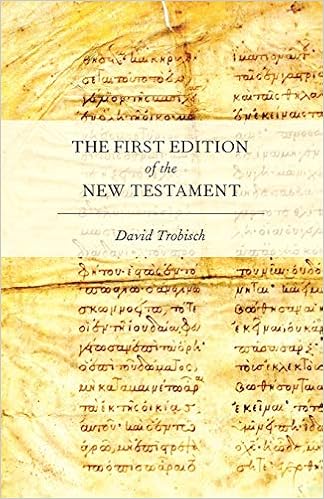In this short but very readable monograph (save for the Greek scattered throughout), Trobisch makes the claim that the New Testament was of early vintage and was the product of a singular editorial hand (even if a group of editors). To make his point, he looks largely into the text itself, comparing how anthologies are put together in our contemporary day to what must have happened back in the first century. Canonization (as opposed to anthologization), by contrast, is a different matter.
As an example of canonization, Trobisch examines the writings of the Christian Fathers, those who came directly after the New Testament. Here, there is significant variance with regard to what is placed into any one collection. One editor might include the letter of Polycarp, while another might drop it or use another rescention. If the New Testament had been canonized over the course of centuries, he claims, as most scholars believe, there would be little agreement as to what belongs in it. Instead, later ancient writers who question the legitimacy and inclusion of certain books in the New Testament are not, Trobisch notes, engaging in arguments over what gets canonized--or rather, included--in the New Testament but rather are engaging in criticism regarding an already established book, even as today's critics do. (This is not to say that there weren't other versions of the "New Testament"; Marcion, for example, created his own, though largely from the larger book, quite possibly already in large distribution.)
Other arguments for the singular editorial hand include the following, some more convincing or easier to understand than others. One is the common set of abbreviations (the Nomina Sacra) used throughout different versions of the manuscripts (though they are not, be any means, used consistently), mainly for the names of God. Another is the common use of the codex rather than the scroll in the early writings. Another is the manner in which the New Testament is arranged, with four distinct parts--Gospels, Acts and General Epistles (called Praxapostolos), Paul's epistles (with Hebrews coming before the pastoral epistles), and Revelation. These allow for easy splitting into separate codexes. They also mirror the pattern of the Old Testament, at least as it is presented in most English Bibles (histories first, then writings and prophecy). The presentation of the General Epistles first, right after Acts, with Paul's following, as is the case in most early manuscripts, also mirrors the presentation of the figures as they appear in Acts (with Paul coming last). Another item pointing to an editor is the uniformity of the naming conventions (Epistle of . . .; Epistle to . . .; Gospel according to . . .). Finally, from very early on, the work was known as the "New Testament" (this is the name all the second-century writers use), suggesting that this was the name the editors affixed to it. A later chapter of Trobisch's book looks at the way the New Testament is cross-referenced such that it sets up a particular unified view of the church and introduces readers to specific characters who can then be identified again later when one comes across their writings or their persona in other portions of the work (e.g., we figure the letters of Peter are from the Peter described in the Gospels, where we first read of him, and mentioned in Acts and Paul's letters, etc.).







No comments:
Post a Comment